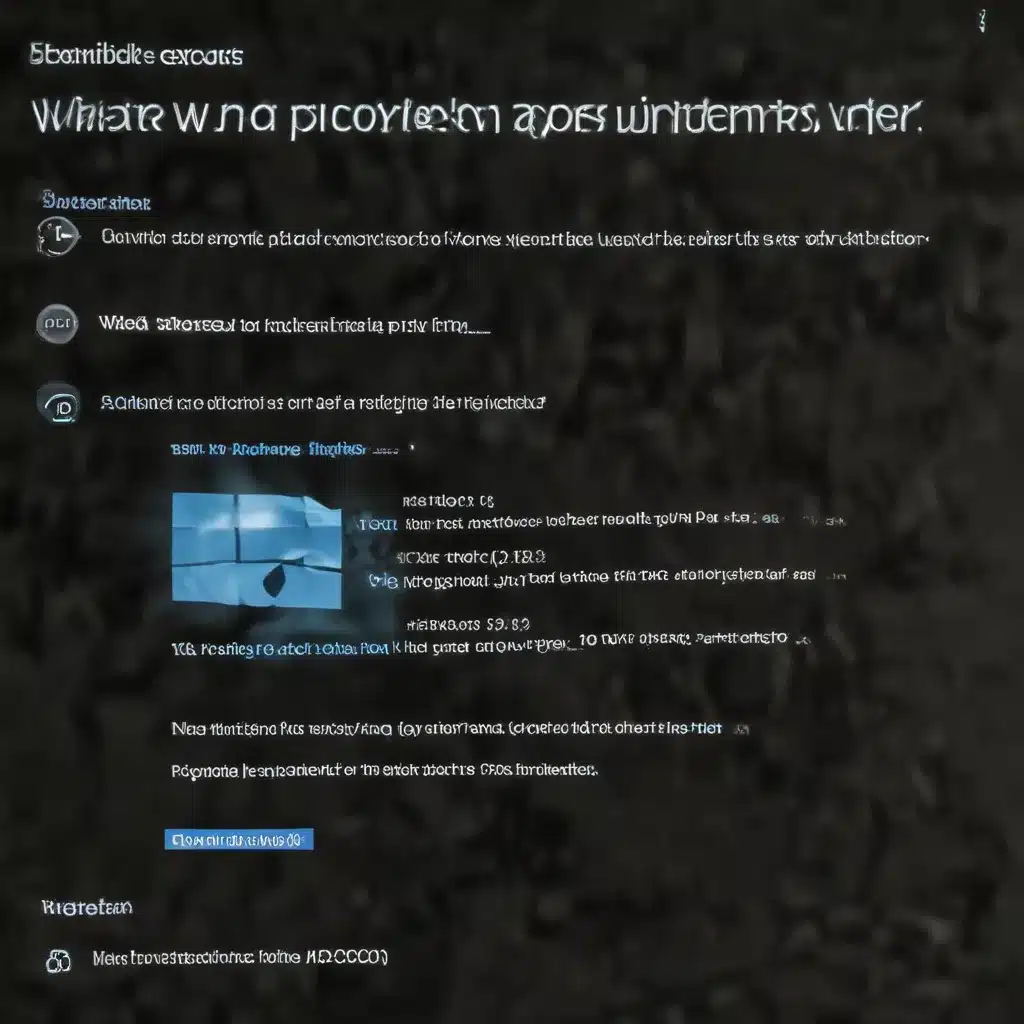
Understanding Windows Error Codes
As an experienced IT professional, I’ve encountered countless Windows error codes throughout my career. These cryptic error messages can be frustrating for users, but they often hold valuable information that can help us diagnose and resolve the underlying issues. In this comprehensive article, we’ll dive deep into the world of Windows error codes, providing practical tips and in-depth insights to help you fix the xxxxxxxxxx error.
Identifying the Error Code
The first step in resolving a Windows error is to identify the specific error code. In the case of the xxxxxxxxxx error, the error code consists of a combination of digits and letters, typically starting with “0x” followed by a series of hexadecimal characters. This error code provides crucial information about the nature of the problem, allowing us to target the root cause more effectively.
Analyzing the Error Code
Once you’ve identified the error code, the next step is to analyze its meaning. Windows error codes are often associated with specific system components, drivers, or software issues. By understanding the underlying cause, we can develop a targeted approach to resolving the problem.
Common Causes of the xxxxxxxxxx Error
The xxxxxxxxxx error can have several possible causes, depending on the specific circumstances. Some of the most common reasons for this error include:
-
Corrupted or missing system files: Windows relies on a vast array of system files to function properly. If these files become corrupted, damaged, or go missing, it can lead to various error codes, including the xxxxxxxxxx.
-
Hardware-related issues: Hardware problems, such as failing components, incompatible devices, or driver conflicts, can also trigger the xxxxxxxxxx error.
-
Software conflicts or incompatibilities: Incompatible software, outdated drivers, or conflicting programs can sometimes cause Windows to encounter the xxxxxxxxxx error.
-
Registry-related problems: The Windows Registry is a critical system database that stores important configuration settings. Corruption or improper modifications to the Registry can contribute to the xxxxxxxxxx error.
-
Malware or virus infections: In some cases, malware or virus infections can interfere with Windows’ normal operation, leading to various error codes, including the xxxxxxxxxx.
Troubleshooting Strategies
Now that we’ve identified the potential causes of the xxxxxxxxxx error, let’s explore some troubleshooting strategies to help you resolve the issue:
1. Run a System File Checker (SFC) scan
The System File Checker (SFC) is a powerful Windows utility that can scan and repair corrupted or missing system files. To run an SFC scan, follow these steps:
- Open the Start menu and search for “Command Prompt.”
- Right-click on the Command Prompt and select “Run as administrator.”
- In the Command Prompt, type
sfc /scannowand press Enter. - The SFC scan will run, and if any issues are found, it will attempt to automatically repair them.
2. Check for hardware-related problems
If the xxxxxxxxxx error persists after the SFC scan, it’s time to investigate potential hardware-related issues. Start by ensuring that all your hardware components are compatible with your system and that their drivers are up-to-date. You can also use Windows’ built-in diagnostic tools, such as the Memory Diagnostic Tool, to check for memory-related problems.
3. Perform a clean boot
Sometimes, software conflicts or incompatibilities can cause the xxxxxxxxxx error. To troubleshoot this, you can perform a clean boot, which loads Windows with only the essential services and drivers. This can help you identify any third-party programs or services that may be contributing to the issue.
- Open the Start menu and search for “System Configuration.”
- In the System Configuration window, go to the “Services” tab and check the “Hide all Microsoft services” box.
- Click “Disable all” to disable all third-party services.
- Next, go to the “Startup” tab and click “Open Task Manager.”
- In the Task Manager, disable all startup items.
- Restart your computer and see if the xxxxxxxxxx error is resolved.
4. Check and repair the Windows Registry
The Windows Registry is a complex and critical system database, and any issues with it can lead to various problems, including the xxxxxxxxxx error. You can use the built-in Registry Editor to diagnose and repair any Registry-related problems.
- Open the Start menu and search for “Registry Editor.”
- In the Registry Editor, navigate to the problematic key or value and try to identify any issues.
- If you’re not comfortable making changes directly, you can try using a Registry repair tool to scan and fix any issues automatically.
5. Scan for malware and viruses
In some cases, the xxxxxxxxxx error may be caused by malware or virus infections. Be sure to run a comprehensive antivirus and anti-malware scan to identify and remove any potential threats.
Preventive Measures
To avoid the xxxxxxxxxx error and other Windows-related issues, it’s important to take proactive steps to maintain the health of your system. Here are some preventive measures you can implement:
-
Keep Windows and all installed software up-to-date: Regularly update your operating system and software to ensure you have the latest security patches and bug fixes.
-
Perform regular backups: Regularly back up your important data to an external storage device or cloud-based service. This will help you recover from any system failures or data loss.
-
Use a reliable antivirus and anti-malware solution: Invest in a reputable antivirus and anti-malware program to protect your system from various threats, including malware that can cause the xxxxxxxxxx error.
-
Monitor system performance: Keep an eye on your system’s performance indicators, such as CPU and memory usage, to identify any potential hardware or software-related issues before they escalate.
-
Maintain a clean and organized file system: Regularly clean up your file system, delete unnecessary files, and organize your data to ensure optimal system performance.
By following these preventive measures, you can significantly reduce the likelihood of encountering the xxxxxxxxxx error and other Windows-related problems.
Conclusion
The xxxxxxxxxx error can be a frustrating issue, but with the right troubleshooting strategies and preventive measures, you can effectively resolve it and maintain the overall health of your Windows system. Remember, as an experienced IT professional, your role is to provide practical solutions and in-depth insights to help your readers overcome their technical challenges.
For more information and resources on Windows error codes and IT solutions, be sure to visit IT Fix, where you can find a wealth of informative articles and expert advice.












